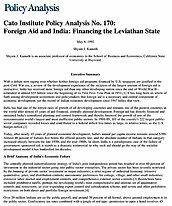India has had one of the lowest rates of growth of all developing countries and remains one of the poorest countries in the world after almost 45 years of aid-financed, centrally planned development. Foreign aid has directly financed and sustained India’s centralized planning and control framework and thereby financed the growth of one of the noncommunist world’s largest and most inefficient public sectors. In 1988–89, 101 of the country’s 222 largest public-sector companies recorded losses and contributed to a federal deficit five times as large, in relative terms, as the U.S. budget deficit.[2]
Today, after nearly 45 years of planned economic development, India’s annual per capita income remains around $300. Almost 40 percent of Indians live below the official poverty line, and the absolute number of Indians in that category increased sharply between the late 1950s and the mid-1980s. In short, India is a paradigmatic case of the failure of government-sponsored aid; it stands as a dramatic testimonial to why such aid should go the way of the socialist development model it has bankrolled for decades.

